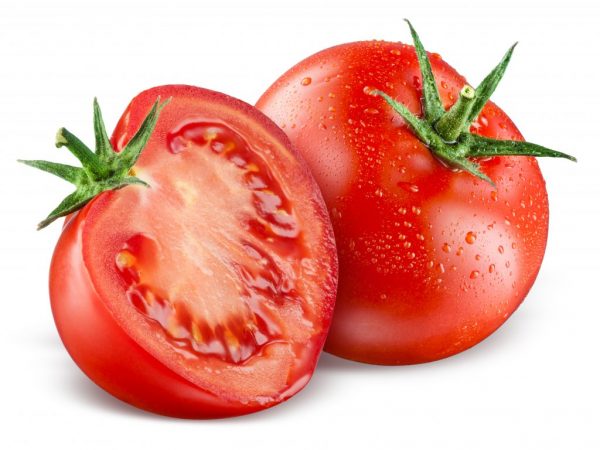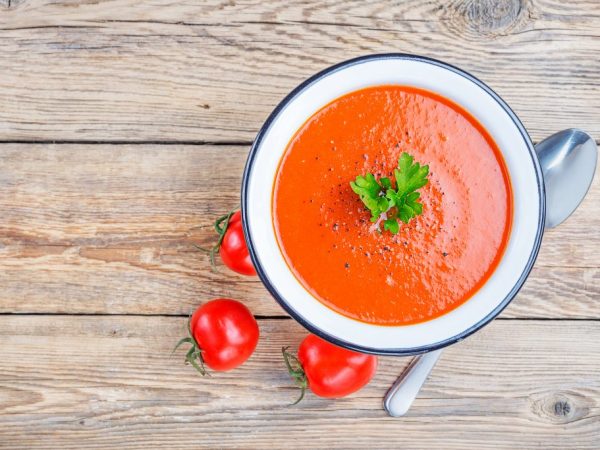Calorie content of fresh and processed tomatoes
Tomatoes are one of the most common and loved by many vegetables. They are often found in diet and cooking recipes. The calorie content of a tomato is small, but it can vary, depending on the variety and method of preparation of the vegetable.

Calorie content of fresh and processed tomatoes
Composition
The calorie content of a fresh tomato depends on its variety and degree of ripeness, but on average it is considered that there are 20 kcal per 100 g of this product.
A medium-sized tomato weighs 140-150 g, thus in 1 piece. contains about 30 kcal.
With a low calorie content, the tomato has a high nutritional value. According to the BZHU table, the composition of 100 g of this product is as follows: carbohydrates - 4-5 g, proteins - 0.6-0.7 g, fats - 0.1-0.2 g.
It is also important for the diet that the vegetable contains slow (complex) carbohydrates with a low glycemic index (30). The benefits of complex carbohydrates for the body are long-term satiety without a sudden release of insulin (which contributes to the accumulation of fat mass). However, all this applies exclusively to fresh tomatoes: after cooking and combining them with various additives, the picture changes dramatically.
Calorie content of different varieties
First of all, the calorie content of tomatoes depends on their sweetness: the sweeter the variety, the more calories it contains. So, the Bull Heart variety contains 26-28 kcal per 100 g (in one piece about 70 kcal, since the tomatoes of this variety are large in size). In addition, meaty tomatoes have a higher calorie content than watery ones.
It is believed that yellow tomatoes contain fewer calories than red and pink ones, however, among the yellow varieties there are sweet ones, and therefore their energy value varies from 15 to 22 kcal. The most dietary of the popular varieties are miniature Cherry tomatoes, which contain 15 kcal per 100 g of product (1 piece contains only 3-4 kcal).
From the cooking method

Calorie content depends on the cooking method
The energy value of baked, stewed or roasted tomatoes always increases, especially if the cooking is carried out with the addition of fats. Boiled tomatoes are subject to minimal changes in this regard.
Baked or stewed vegetables, as well as grilled tomatoes contain from 30 to 36 kcal per 100 g. However, much depends on additives: there are more calories in tomatoes cooked with added sugar, and their glycemic index also increases.
How many calories are in a dried or dried tomato? Depending on the preparation method and the amount of additional ingredients, this product may contain from 240 to 300 kcal per 100 g
Pickled or barrel tomatoes contain even fewer calories than fresh tomatoes: about 15-16 kcal per 100 g. However, because of the salt content, pickled vegetables are not recommended for use in the diet, as well as during pregnancy and during the period when the child is on breastfeeding.
In juices and sauces
The benefits and harms of juices and sauces for the diet also depend on the composition and method of preparation.For health and weight loss, it is better to use home-cooked juices, and not purchased ones. If you still need to choose a product in a store, you need to make sure that there are as few foreign additives as possible in it. Homemade tomato juice made from fresh tomatoes without sugar and other additives is a healthy dietary drink, 100 g of which contains about 16 kcal. But the juice that we buy in stores can have a very different composition and a higher energy value.
As for sauces, ketchups and various pastes, they cannot consist of tomato gruel alone and most often contain a lot of additives. The calorie content of a product is most influenced by the amount of sugar and fat, as well as thickeners and emulsifiers. When preparing sauces at home, you can regulate their energy value, independently deciding how much to put in, and besides, you will be sure that there are no harmful additives in the product.
Recommendations
- The energy value of ready-made meals depends on the compatibility of tomatoes with other ingredients. Tomatoes are well digested with cucumbers, cabbage and durum pasta, but you should not combine them with baked goods.
- What dressing goes well with tomatoes and minimizes the calorie content of fresh fruit salad? A small amount of olive oil or low-fat sour cream is the best option.
- For juice or sauce, it is better to use a sweeter variety of tomatoes than to sweeten the sour fruits with white sugar. In the first case, we consume fructose and glucose, and in the second - fast carbohydrates, due to which the glycemic index of the dish greatly increases.
- Despite the fact that the energy value of unripe fruits is lower than ripe ones, you should not abuse them when losing weight. Fully ripe fruits dull the feeling of hunger better and contain much more useful trace elements.


